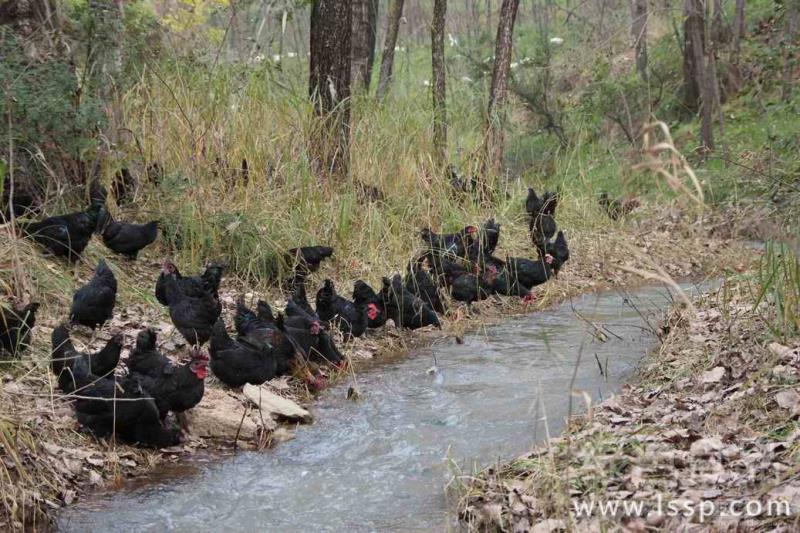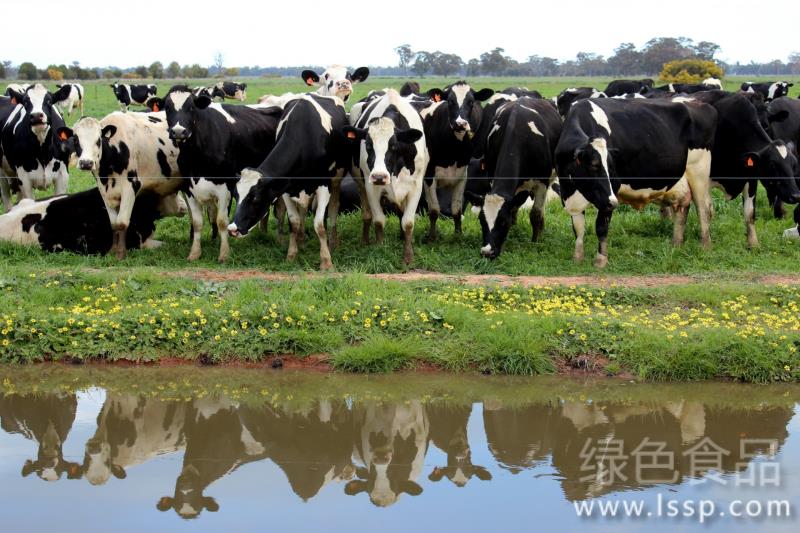How to use woodland scale for stocking black-bone chickens that are not suitable for online breeding
Black-bone chicken is fresh, fragrant, sweet, delicious and deeply loved. Green ears, black meat and black bones are the characteristics of black-bone chicken. As the black-bone chicken does not adapt to the scale of centralized online breeding, the editor is now to introduce the scale of black-bone chicken woodland stocking.

Black-bone chicken stocking
(1) Chicken farm selection: black-bone chicken farms should be far away from residential areas and main roads, requiring a quiet environment, fresh air, adequate water sources and easy access to electricity. The scale of black-bone chicken farm can be determined according to local conditions in natural forests, artificial tea factories, orchards and other places.
(2) Chicken house construction: build a chicken coop sitting north to south on the leeward and sunny flat. The old house can be renovated or another can be built. The unheated chicken house is about 20 square meters. The installation mesh diameter of the chicken house is 1 cm, and the elastic plastic mesh is 80 cm from the ground. It can build 2 Mel and 3 layers, and the distance between the layers is 20cm. Breeding chickens, commercial chickens and breeding sheds are determined according to the number of black-bone chickens raised. The henhouse sets up a wooden bed 80cm above the ground, it can build 2Mel 3 floors, the distance between the layers is 20cm, and the aisle is built with wooden ladders to meet the black-bone chicken's habit of resting high. Breeding 200 black-bone chickens requires 10 mu of land, enclosed around, raising 2000 commercial black-bone chickens, not less than 20 mu, surrounded by fences to prevent attacks by wild beasts and wild birds. The fence is determined according to the number of black-bone chickens. Feed storage rooms, veterinary rooms, studios, duty rooms, changing rooms, disinfection rooms and disinfection pits are required in the chicken farm. There should be a certain isolation zone between the living area of chicken farm staff and the chicken farm. The construction outside the chicken farm, such as the treatment of chicken manure, the treatment of sick and dead chickens and other harmless treatment facilities.
(3) entering chicken: in the early stage of the introduction of black-bone chicken, complete the comprehensive disinfection of chicken farms and appliances, and prepare feed and commonly used medicine. The introduction of black-bone chicken adopts the way of introducing chicken seedlings or unheated chickens.
(4) feeding at room temperature: room temperature: 37 ℃ at 1 week old, 35 ℃ at 3 week age, and 23 ℃ at 4 week age. It can also be reduced by 0.5 ℃ every day after 1 week age, and can be removed at 5 weeks. The humidity in the mountain area doesn't have to be taken into account. Replenish the light with electricity: keep 24 hours of light every day for the first week, and then reduce it by 1 hour a day to nature. Drink and eat at the right time. Chicken seedlings should start eating and drinking water as soon as possible. Warm water with 5% glucose should be used for drinking water in the first week, and penicillin should be added to the first 3 days of drinking water. Feed the black-bone chicken after drinking water for 3 hours. The full price material with 19% protein content can be eaten freely. In the second week, veterinary drugs to prevent white dysentery were added to the feed, and veterinary drugs to prevent coccidiosis were added to the feed in the third week. The brooding density of black-bone chickens less than 15 days old is 600.70 chickens per square meter. Generally, each batch of black-bone chickens is raised at 2000 chickens (the brooding scale is determined according to the demand for chicks in the farm). The chicken manure is cleaned regularly every day, and the chicken manure can be transferred to breeding at the age of 35 days.
Black-bone chicken breeding forest
(5) feeding during the breeding period: the combination of feeding and feeding, according to the proportion of 39% protein concentrate of broilers mixed with 3 jin of corn flour, mixed evenly until the black-bone chicken grows to 1 kg. In the 1.5 kg stage, one jin of concentrated material was mixed with 5 jin of corn flour and fed evenly. After 1.5 kilograms of black-bone chicken feed without concentrate, supplemented with corn, wheat and other miscellaneous grains, 20ml can be sold in 30 days. Generally speaking, the male black-bone chicken can be fenced in 120 days, and the female black-bone chicken can be fenced in 140 days. Excellent hens and cocks can be selected and raised by themselves to reduce the introduction of epidemic diseases, and black-bone chickens can also be provided to the market. Black-bone chicken farms that do not breed must all go in and out. Where there are conditions, forage grasses can be planted appropriately to make up for chlorophyll, vitamins and protein of native chickens.
(6) epidemic prevention and disinfection: the key to epidemic prevention of large-scale raising chickens in woodland is to do a good job of vaccination and disinfection of black-bone chickens. Regular vaccination, disinfection and deworming of black-bone chickens are beneficial to improve the commodity rate and economic income of black-bone chickens. The immunization procedure of black chicken: 1-day-old black-bone chicken was vaccinated with Marek's vaccine, 7-day-old black-bone chicken drank Newcastle disease Ⅳ vaccine, 9-day-old black-bone chicken drank bursa B87 vaccine, 12-day-old black-bone chicken drink branch H120; 28-day-old black-bone chicken drink chicken once Newcastle disease Ⅱ vaccine; 30-day-old black-bone chicken was vaccinated with avian influenza vaccine, 60-day-old black-bone chicken was vaccinated with Newcastle disease Ⅰ vaccine again, and no longer vaccinated after 60 days old. Disinfection forms a system, including disinfection of chickens once a week in chicken farms. 65-day-old and 95-day-old black-bone chickens were dewormed regularly. Often check the chicken droppings, observe the food and drinking water of the chickens. Diseased chickens should be isolated immediately, diagnosed and eliminated, and healthy chickens should be treated with the right medicine.
- Prev

Rock salt can control deer bite hair.
The bite problem of deer, also known as hair eating disease, is a chronic metabolic disease caused by abnormal taste due to the dysfunction of digestive tract and nervous system. The main causes are late winter and early spring, long-term feeding by rain, sun-dried hay or improper feeding and management, incomplete nutrition, excessive deer density and so on. The incidence is sometimes as high as 100%. At the beginning of the disease, only a few deer bite, and then most deer bite each other, and some will bite off the hair and swallow it in a ball after a little chewing, which can be rolled with the peristalsis of the stomach.
- Next

Cow abortion is caused by many factors, which lead to careful prevention of cow abortion.
Cow abortion is caused by many factors, which lead to careful prevention of cow abortion.
Related
- On the eggshell is a badge full of pride. British Poultry Egg Market and Consumer observation
- British study: 72% of Britons are willing to buy native eggs raised by insects
- Guidelines for friendly egg production revised the increase of space in chicken sheds can not be forced to change feathers and lay eggs.
- Risk of delay in customs clearance Australia suspends lobster exports to China
- Pig semen-the Vector of virus Transmission (4)
- Pig semen-the Vector of virus Transmission (3)
- Five common causes of difficult control of classical swine fever in clinic and their countermeasures
- Foot-and-mouth disease is the most effective way to prevent it!
- PED is the number one killer of piglets and has to be guarded against in autumn and winter.
- What is "yellow fat pig"? Have you ever heard the pig collector talk about "yellow fat pig"?

